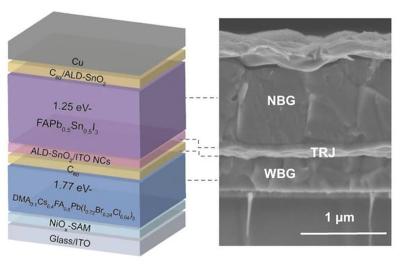Researchers from Nanjing University and University of Electronic Science and Technology of China have designed an all-perovskite tandem solar cell based on a wide bandgap perovskite top cell relying on a two-dimensional/three-dimensional heterostructure and a narrow bandgap bottom cell.
Schematic of the solar cell structure and the corresponding cross-sectional SEM image of an all-perovskite tandem solar cell. Image from Nature Communications
The research group used a generic 3D-to-2D perovskite conversion approach to fabricate the top cell. They first deposited a lead-halide perovskite (methylammonium lead iodide - MAPbI3) layer by a hybrid evaporation/solution method and then transformed the layer into a 2D structure via a long-chain ammonium ligand.
The device is based on a substrate made of glass and indium tin oxide (ITO), a hole transport layer (HTL) made of nickel(II) oxide (NiOx) and a self-assembled monolayer (SAM), the perovskite absorber, a buckminsterfullerene (C60) electron transport layer, a bathocuproine (BCP) buffer layer, a tin(IV) oxide (SnO2) layer, and a copper (Cu) metal contact.
“The resulting 2D/3D heterostructure effectively accelerates the charge extraction at the perovskite/C60 interface and thereby suppresses light-induced halide segregation,” the researchers said, noting that this top cell achieved an energy bandgap of 1.78 eV. The device also achieved a power conversion efficiency of 19.6%, an open-circuit voltage of 1.324 V, a short-circuit current density of 17.9 mA cm−2, and a fill factor of 83.0%. It was also able to retain 95% of its original efficiency after 1,000 h.
For the construction of the all-perovskite tandem solar cell, the research team also used a 21.3%-efficient bottom perovskite cell based on an ITO substrate, a narrow bandgap perovskite, a C60 electron transport layer, a SnO2 layer, and a Cu metal contact.
The champion device built with this configuration reached an efficiency of 28.1%, an open-circuit voltage of 2.135 V, a short-circuit density of 16.2 mA cm−2, and a fill factor of 81.5%. It also retained 90% of its initial efficiency after 855 h of continuous operation.
“This study notably reveals the degradation mechanism of wide bandgap perovskite devices and proposes an unprecedented technical approach to simultaneously improving efficiency and stability,” the team concluded.




